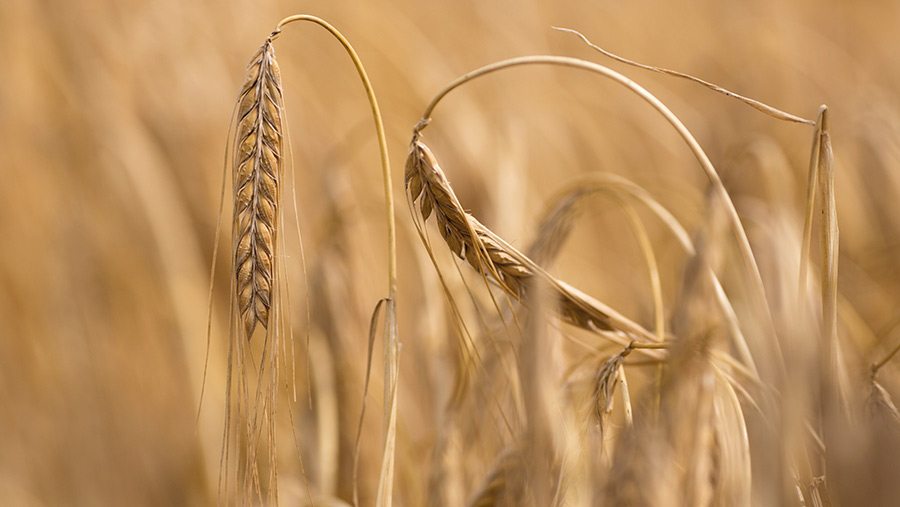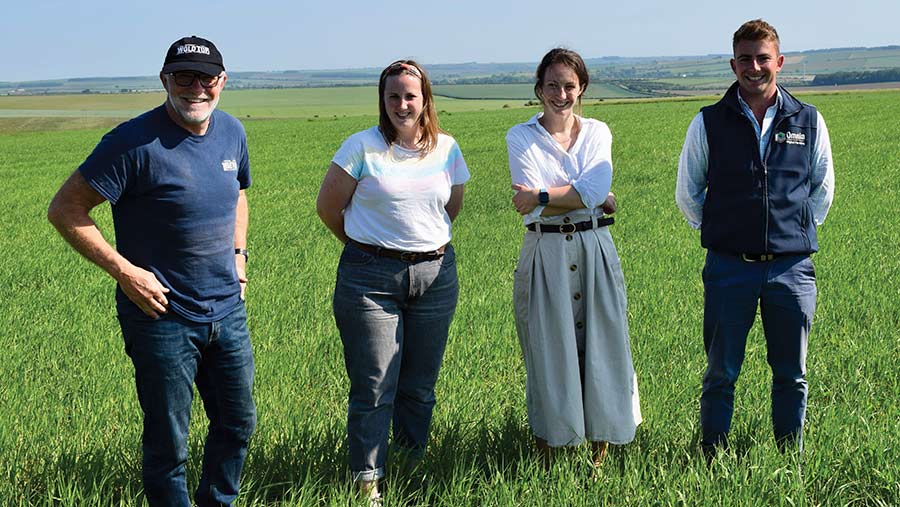How Wold Top Brewery barley grower lowered carbon footprint
 © Tim Scrivener
© Tim Scrivener The Yorkshire farming family behind the successful Wold Top Brewery and Yorkshire’s first single-malt whisky distillery is using the latest precision mapping technology in its drive towards a low-carbon, sustainable future.
Carbon and soil health are a major focus at Hunmanby Grange and third-generation farmer Tom Mellor has long recognised the importance of these given his passion for sustainability and regenerative agriculture principles.
See also: SFI 2023: What’s on offer for arable farmers
Hunmanby Grange Farm
- 240ha family farm
- Shallow lime-rich soils over chalk
- Cropping includes spring barley, winter barley, winter wheat, land rented for potatoes, and overwinter cover crops
- Strong environmental focus, with stewardship margins and wildlife-rich grassland (AB15 two-year ley)
- Most arable work done by local contractor, apart from drilling in autumn and spring
- Diversified into brewing in 2003, when Wold Top Brewery was founded, and in 2012 when the Spirit of Yorkshire Distillery was established
- Strong focus on sustainability and regenerative farming principles
Cultivation carbon costs
Overwinter cover crops have been part of the rotation for more than five years, and Tom is working with Future Food Solutions to evaluate their value for carbon sequestration.
In 2018, the farm moved to direct-drilling, although he recognises the need to remain flexible and adapt to situations as they arise.
For example, targeted shallow ploughing is being considered as a cultural control for grassweeds, notably brome, which has become more problematic on some fields.
Tom also appreciates the value of using outside expertise where necessary.
Two years ago, he started working with local Hutchinsons agronomist Ben Jagger, and farm business consultant Will Foyle, to help plan the farm’s strategic direction, as well as assist with day-to-day agronomy.
This started with analysis of 2022 field performance and production costs using Omnia Business Manager.
Yield maps were uploaded to the system, and combined with agronomic records from Muddy Boots, financial costings, and other information from the farm’s contractor, including field operations, machinery types, fuel consumption and work rates.
This allowed them to include both the carbon cost in terms of fuel use, but also the embedded carbon (that associated with the manufacture of the machinery) when benchmarking performance.
Using this information, the Omnia system mapped variations in variable and direct costs across individual fields in £/ha, and showed the associated carbon “cost” (carbon dioxide equivalents (CO2e)/ha).
One particularly interesting insight was the comparison between two fields of Gleam winter wheat; one direct-drilled in 2021-22, the other ploughed, pressed and drilled.
The direct-drilled field averaged 9.56 t/ha, and had a total operation cost of £270/ha, or 1.57t/ha CO2e, equating to 0.16t of carbon dioxide/t.
In contrast, the ploughed field cost more to establish at £400/ha, but the higher average yield of 10.91t/ha diluted the carbon cost to 1.61t/ha CO2e or 0.15t of carbon dioxide/t.
“This one example shows how it is important to take into account the impact of yield dilution when assessing costs and carbon.
“But, equally, production systems have to be financially, agronomically and environmentally sustainable, so we can’t consider anything in isolation,” says Ben.
Mapping soils
Full Terramap analysis of the whole farm over the past two seasons provides a further layer of information, including detailed mapping of all major soil properties, such as nutrient levels, pH, soil texture, organic matter, and carbon, with results uploaded to Omnia.
Interestingly, this shows that in the two fields with contrasting establishment systems, organic and active carbon levels were both lower in the ploughed field compared with the direct-drilled area, possibly due to the oxidation of organic matter within the inverted soil.
It again highlights the complexity of decision making, as while ploughing may not be the best solution in terms of soil carbon or establishment costs, the increase in brome populations in some direct-drilled fields could have a more damaging long-term effect if left unchecked, through reduced yields and the need for control.
The team insists it is still early days in terms of identifying the optimum balance in terms of what is best financially, agronomically and environmentally, but understands that accurately measuring the variables involved and benchmarking performance is key to making more informed decisions.
It is hoped that being able to quantify the carbon footprint of barley going into the brewery will also help them achieve their ambition to produce “carbon-neutral beer” sometime in the near future.
“It would be a really good unique selling point if we could one day say that all the barley going into our beer is carbon neutral, as well as being produced from our own farm,” says Kate.
“At the moment, we’re probably about three-quarters of the way there, but zero carbon is something we’d like to achieve.”
Cutting carbon
Artificial fertiliser is the biggest contributor to the carbon footprint of many arable crops, and Ben says this is an area where there may be scope to improve.
“Achieving high nutrient use efficiency is a challenge on the shallow, chalky soils, so we’re trying to assess where there are opportunities to reduce inputs without jeopardising grain quality or yield.”
For nitrogen, wheats typically receive 180-200kg/ha of N, winter barley gets 150 kg/ha of N and spring barley nearer 130 kg/ha of N.
In the past two seasons, which were both very dry, Omnia analysis has helped trim total applied nitrogen on winter and spring barley by 10kg/ha, with no reduction in yield or quality, he notes.
“It’s a start. We’re still looking to find where the equilibrium is for this farm, but all the time have to be mindful that what we do in the field has implications for other parts of the business in terms of grain quality and brewing potential.”
Using the soil mapping analysis to better understand the interactions between soil properties, nutrient availability, and the impact of cover crops will also help with such decision-making, says Kate, and may open up opportunities for savings in the future.
Brewing and distilling success at Wold Top brewery

Left to right: Tom Mellor, Kate Balchin, Jenni Ashwood, Ben Jagger © Paul Spackman
Ever since the Mellor family moved to Hunmanby Grange Farm in 1945, successive generations have always recognised the importance of driving the business forward.
Third-generation farmer Tom Mellor is no exception, and believes the need to adapt has never been greater given agriculture’s current pace of change, volatile markets, and binding government targets to reduce carbon, which are gradually filtering through to producers.
“Farming is moving at a pace I’ve not seen in my lifetime, and I’m sure we’ll face many new challenges in the next 10-15 years, so it’s vital we plan for this and keep moving forward.”
Natural synergy
It is 20 years since Wold Top Brewery was established by Tom and his wife Gill, initially to diversify income during a tough period for farming, adding value to spring barley grown on the 240ha farm.
The brewery, now managed by Tom’s daughter, Kate Balchin, has grown into a hugely successful business in its own right, producing a range of award-wining cask, keg and bottled beers sold nationwide.
In 2012, Tom and business partner David Thompson also established the Spirit of Yorkshire Distillery, of which his other daughter, Jenni Ashwood, is now the marketing director.
There remains a strong natural synergy between the businesses, with sustainability and provenance at its core.
The brewery still proudly uses nearly all home-grown barley, about 500t annually, with the main variety being Laureate, plus some Vessel, the only non-GN (glycosidic nitrile) winter malting barley on the UK market.
Barley is bought by the brewery from the farm at the going market price, sold to a local maltster, Muntons, then that ring-fenced batch of malted barley is bought back for brewing.
“It’s not just that we’re using home-grown barley in our brewing and distilling, but we also have complete control over how it is grown,” Tom says.
While the diversification has been very successful, he is keen to ensure the farm remains financially and environmentally sustainable, independent from the other enterprises.
“The farm is the heart of our business, so it’s really important it’s profitable and not just a vehicle for allied parts of the business.”

